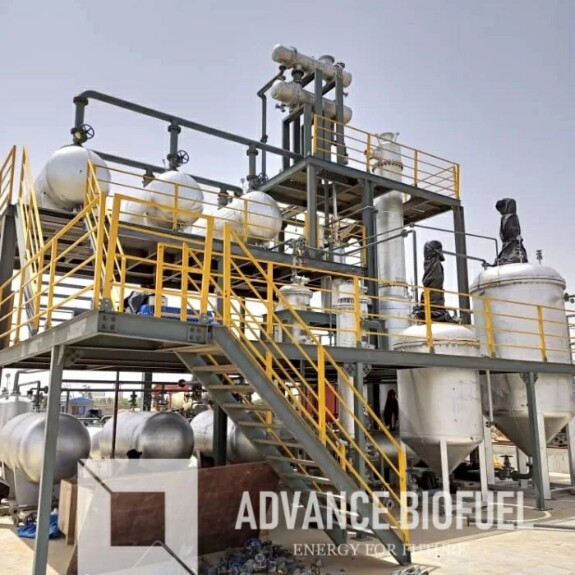From Feedstock to Fuel: The Journey of a Biodiesel Manufacturing Plant

Biodiesel has emerged as a key player in the renewable energy landscape, offering an eco-friendly alternative to traditional fossil fuels.
The journey from raw materials to biodiesel is a fascinating process that involves various stages, all of which occur within the confines of a biodiesel manufacturing plant.
This journey is not only vital for producing clean fuel but also contributes significantly to reducing carbon emissions and promoting sustainable energy practices.
In this article, we will explore the steps involved in the biodiesel production process, from the initial feedstock to the final fuel product.
Sourcing the Feedstock
The foundation of biodiesel production begins with the selection of suitable feedstock.
Feedstock refers to the raw materials used to create biodiesel, typically sourced from vegetable oils, animal fats, and used cooking oil.
Some common vegetable oils used include soybean oil, palm oil, and rapeseed oil, while animal fats, such as beef tallow and pork lard, can also be processed.
Feedstock refers to the raw materials used to create biodiesel, typically sourced from vegetable oils, animal fats, and used cooking oil.
Some common vegetable oils used include soybean oil, palm oil, and rapeseed oil, while animal fats, such as beef tallow and pork lard, can also be processed.
This not only reduces reliance on virgin oils but also helps address waste management challenges.
The choice of feedstock is critical because it influences the quality, cost, and sustainability of the biodiesel produced.
Pre-Treatment of Feedstock
Before the actual biodiesel production process can begin, the feedstock must undergo a pre-treatment phase.
This involves cleaning and refining the raw materials to ensure they are suitable for processing.
For example, used cooking oil and animal fats may contain impurities, including water, dirt, or solid particles.
These contaminants need to be removed to avoid disrupting the chemical reactions that occur during biodiesel production.
The feedstock is also evaluated for its free fatty acid (FFA) content. High FFA levels can hinder the biodiesel conversion process, so they are often reduced during pre-treatment to improve the efficiency of the reaction.
Transesterification: The Core Process
This process converts the feedstock oils and fats into biodiesel by reacting them with alcohol, typically methanol, in the presence of a catalyst, usually sodium or potassium hydroxide.
The transesterification process breaks down the triglycerides (fats and oils) in the feedstock into glycerin and methyl esters, which are the chemical components of biodiesel.
During this phase, glycerin, a byproduct, is separated and collected for use in other industries, while the methyl esters are purified to become biodiesel.
This step is the most critical in transforming raw feedstock into a usable fuel that meets biodiesel standards.
The success of this process determines the fuel's quality and compatibility with diesel engines.
Purification and Refining of Biodiesel
Once the transesterification process is complete, the resulting biodiesel must undergo purification to remove any remaining impurities, such as unreacted methanol, glycerin, or catalysts.
Purification can be done through various methods, including water washing, dry washing, or distillation.
The goal of purification is to ensure that the biodiesel meets the stringent quality standards required for use in vehicles and industrial applications.
The refined biodiesel is then tested for its properties, such as viscosity, cetane number, and sulfur content, to ensure compliance with industry regulations.
Storage and Distribution
After purification, the biodiesel is ready for storage and distribution.
Biodiesel can be blended with traditional diesel fuels in various proportions, such as B5 (5% biodiesel) or B20 (20% biodiesel), depending on the application.
It can also be used as B100, or pure biodiesel, in certain engines designed for renewable fuel use.
The biodiesel is stored in large tanks before being distributed to fuel stations, industries, or transportation fleets.
Proper storage conditions are essential to maintaining fuel quality, and tanks must be designed to prevent contamination and oxidation.
Environmental Impact and Benefits
The journey from feedstock to fuel in a biodiesel manufacturing plant is not just about producing an alternative energy source; it is also about contributing to environmental sustainability.
Biodiesel is biodegradable, non-toxic, and produces fewer greenhouse gas emissions than conventional diesel.
By using renewable feedstock, such as waste oils or animal fats, biodiesel plants can significantly reduce the carbon footprint associated with fuel production.
Moreover, biodiesel helps reduce dependence on fossil fuels and supports local economies by creating jobs in feedstock collection, processing, and fuel distribution.
Its use in transportation and industrial applications further promotes cleaner air and a healthier environment.
Conclusion
The journey of biodiesel from feedstock to fuel is a remarkable example of how renewable energy technologies can transform waste materials into valuable resources.
Each step in the process, from sourcing feedstock to the final purification of biodiesel, is crucial for ensuring the production of high-quality, sustainable fuel.
As the world continues to seek cleaner and more efficient energy solutions, biodiesel manufacturing plants play a vital role in meeting the growing demand for renewable energy.
If you are considering investing in renewable energy solutions for your business, partnering with a trusted biodiesel manufacturer is essential.
Advance Biofuel, located in Ahmedabad, is at the forefront of biodiesel production, offering reliable and innovative solutions for businesses looking to make a positive impact on the environment.
By understanding the process behind biodiesel manufacturing, businesses can make informed decisions that benefit both their operations and the planet.